Dogs bring immeasurable joy and companionship into our lives, but for many, the constant shedding of fur can be a significant concern. Beyond the hassle of cleaning up dog hair, shedding is often associated with pet allergies, making it challenging for allergy sufferers to enjoy the benefits of dog ownership. While no dog is 100% “non-shedding” or truly “hypoallergenic,” many breeds are known for their significantly lower shedding tendencies, making them excellent choices for cleaner homes and potentially fewer sniffles.
If you’re among those searching for dog breeds that don’t shed too much, you’re in the right place. This comprehensive guide will walk you through understanding what causes shedding and allergies, clarify the difference between “hypoallergenic” and “low-shedding,” and introduce you to over 25 fantastic low-shedding breeds. Whether you’re looking for a tiny breed dog that doesn’t shed or a larger companion, we’ll help you find a furry friend that fits your lifestyle without leaving a carpet of hair behind.
Understanding “Hypoallergenic” vs. “Low-Shedding”: The Key Difference
The term “hypoallergenic dog” is widely used but often misunderstood. It implies a dog that won’t trigger allergies, but in reality, no dog is 100% allergen-free. All dogs produce allergens, primarily in their dander (flakes of dead skin), saliva, and urine, not just their hair. However, dogs that shed less release fewer of these allergens into their environment.
Low-shedding breeds typically have coats that trap loose hair and dander, preventing them from scattering throughout your home. This means less fur on your furniture and clothes, and consequently, fewer airborne allergens. For individuals with mild to moderate dog allergies, these breeds can make a significant difference in managing symptoms like coughing, itching, or wheezing, allowing them to enjoy the companionship of a canine friend. It’s crucial to remember that while these dogs are a better fit for allergy sufferers, consistent grooming and a clean living environment are still essential.
Top Dog Breeds That Don’t Shed Too Much
Here’s a detailed look at some of the best dog breeds that don’t shed too much, each offering unique qualities and charm.
1. Poodle
 White Standard Poodle standing gracefully in a grassy park
White Standard Poodle standing gracefully in a grassy park
Poodles are renowned not only for their elegant appearance and exceptional intelligence but also for their minimal shedding coats. Available in Standard, Miniature, and Toy sizes, there’s a Poodle to fit almost any living situation. Their curly, dense coat traps loose hair and dander, making them an excellent choice for allergy sufferers. Despite their low shedding, Poodles require regular and thorough grooming—often daily brushing and professional clipping every 4-6 weeks—to prevent matting and maintain coat health. Originally bred as water retrievers, Poodles are active and highly trainable dogs that thrive on mental and physical stimulation.
2. Yorkshire Terrier
 Blue and tan Yorkshire Terrier lounging comfortably on an armchair
Blue and tan Yorkshire Terrier lounging comfortably on an armchair
Known affectionately as “Yorkies,” these small dogs boast spunky personalities packed into a tiny frame, making them one of the most popular small dog breeds that don’t shed much. Their silky, fine hair is more akin to human hair than typical dog fur, which means it sheds very little. Yorkies are adaptable companions, equally happy in a spacious house or a cozy apartment, provided they receive ample attention and love from their families. Daily brushing is essential to keep their long coats free of tangles and mats, and many owners opt for a shorter “puppy cut” for easier maintenance.
3. Shih Tzu
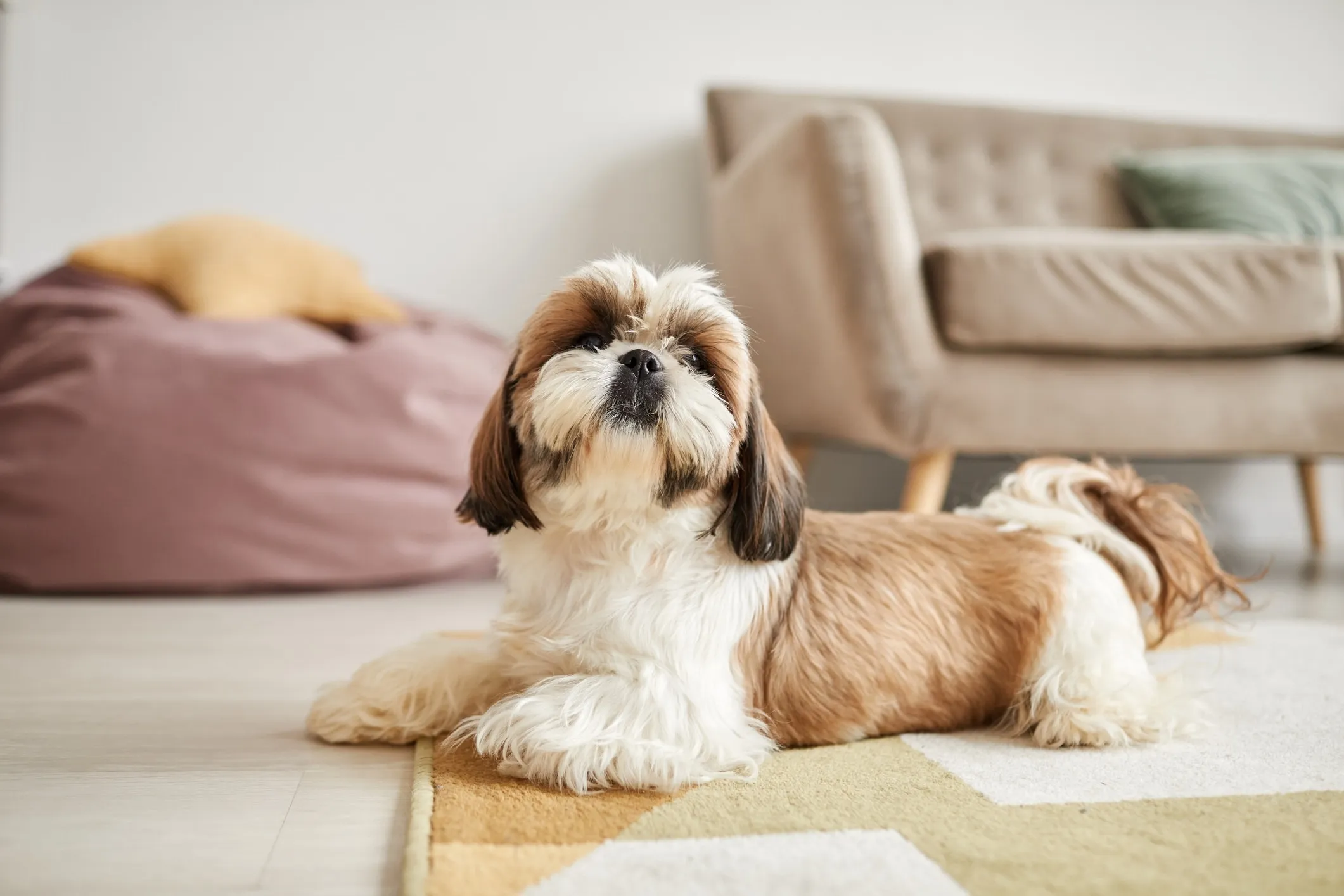 Brown and white Shih Tzu relaxing on a living room floor
Brown and white Shih Tzu relaxing on a living room floor
The Shih Tzu, an ancient companion breed with a friendly and outgoing temperament, is another excellent option for those seeking a low-shedding dog. Their luxurious double coat, though thick, sheds minimally but requires diligent daily brushing to prevent tangles and mats. While their charming flat faces are adorable, they can predispose Shih Tzus to certain health issues, including breathing difficulties and overheating in warm weather. Regular eye cleaning is also important to manage tear stains. Despite these considerations, their affectionate nature makes them wonderful family pets.
4. Miniature Schnauzer
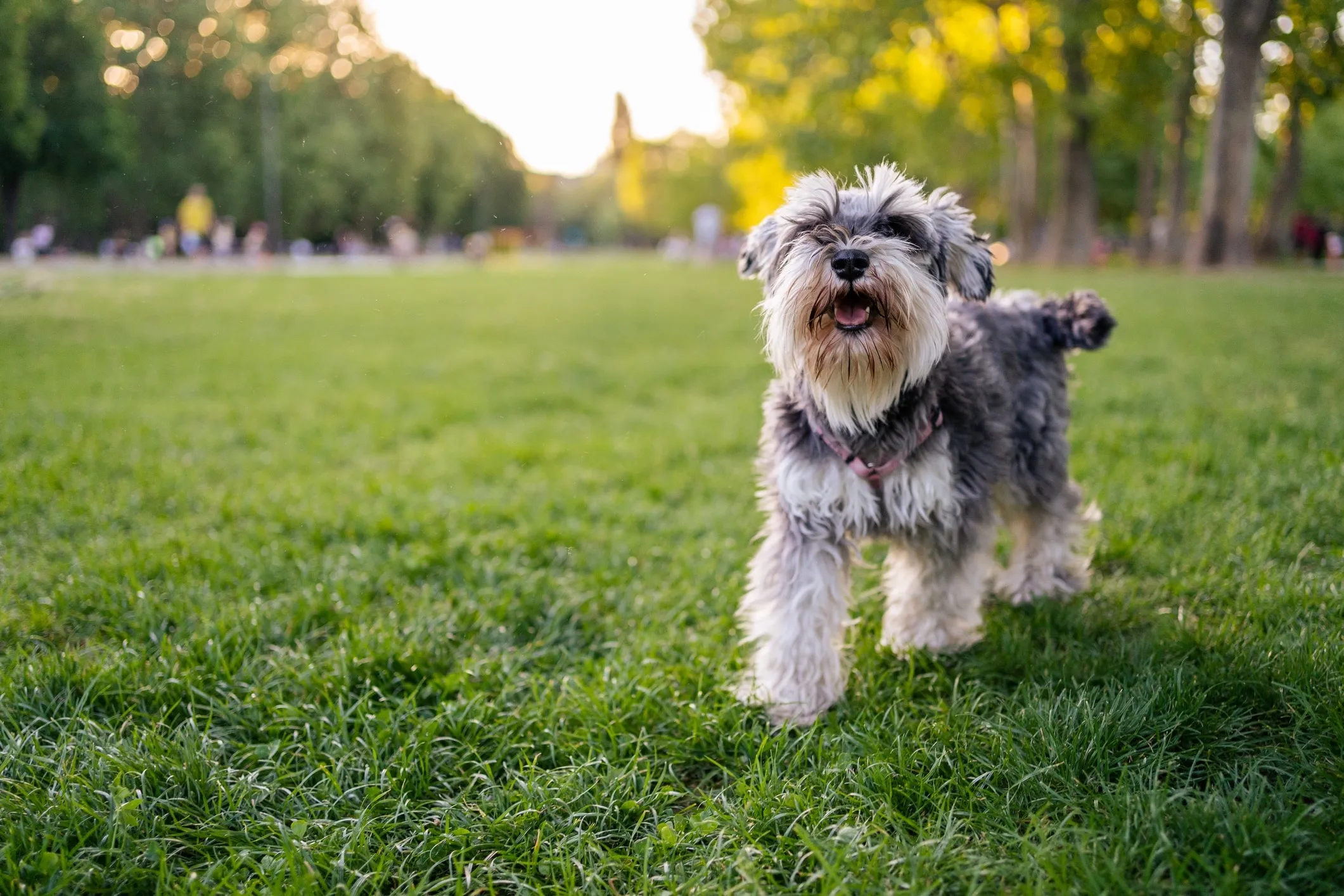 Salt and pepper Miniature Schnauzer wearing a pink harness in a park
Salt and pepper Miniature Schnauzer wearing a pink harness in a park
The Miniature Schnauzer is the smallest of the three Schnauzer breeds, typically standing no more than 14 inches tall and weighing between 10-20 pounds. These intelligent and robust little dogs have a wiry double coat that sheds very little, making them a popular choice among dog breeds that don’t shed too much. Their distinctive beard and eyebrows give them a unique, charming appearance. Miniature Schnauzers are energetic and require at least an hour of exercise daily, alongside regular grooming (brushing and professional stripping or clipping) to keep their coat in top condition. They are known for being alert, spirited, and devoted companions.
5. Standard Schnauzer
 Gray Standard Schnauzer standing alert in a grassy field
Gray Standard Schnauzer standing alert in a grassy field
Sharing many desirable traits with their miniature counterparts, the Standard Schnauzer offers a larger package, weighing up to 45 pounds. This breed also features a wiry, low-shedding coat and is highly intelligent and protective, making them excellent watchdogs and loyal family members. Standard Schnauzers are active dogs that thrive on daily walks, games of fetch, and mental challenges. Like all Schnauzers, they require consistent grooming, including brushing and periodic hand-stripping or clipping, to maintain their iconic look and prevent shedding.
6. Giant Schnauzer
 Black Giant Schnauzer with a blue bow collar, wet from playing in a park
Black Giant Schnauzer with a blue bow collar, wet from playing in a park
Among the largest dog breeds that don’t shed too much, the Giant Schnauzer can reach over 27 inches tall and weigh up to 85 pounds. Despite their imposing size, they possess the same low-shedding, wiry coat as their smaller relatives. Giant Schnauzers are powerful, intelligent, and require extensive exercise and training to be happy and well-behaved. They excel in activities like hiking, running, and vigorous playtime. Their loyalty and protective instincts make them excellent guardians, but they need experienced owners committed to their significant physical and mental needs, including regular grooming. For more options for larger low-shedding companions, consider exploring other largest dog breeds that don’t shed.
7. Bichon Frise
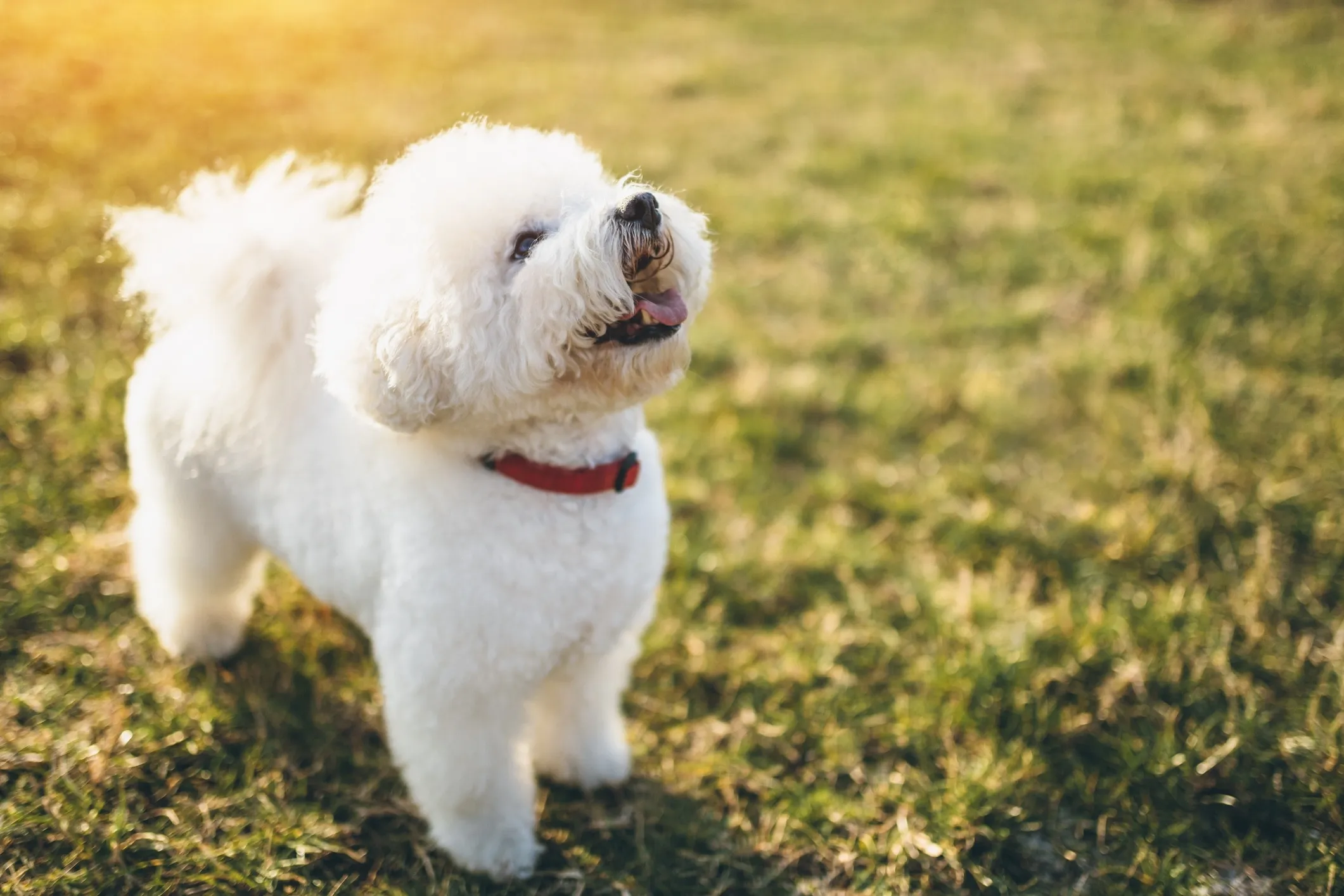 White Bichon Frise dog looking curiously upwards in the grass
White Bichon Frise dog looking curiously upwards in the grass
The Bichon Frise is a cheerful, playful, and affectionate small dog with a distinct powder-puff coat that sheds minimally. Their curly white hair, reminiscent of cotton, traps loose fur, making them a popular choice for those with allergies. Bichons are highly intelligent and eager to please, responding well to positive reinforcement training and quickly mastering tricks. They are adaptable to various living situations and make delightful companions, thriving on human interaction. However, their beautiful coat requires daily brushing and regular professional grooming to prevent matting and keep them looking their best.
8. Chinese Crested
 Black hairless Chinese Crested dog looking at the camera with a curious expression
Black hairless Chinese Crested dog looking at the camera with a curious expression
The Chinese Crested is truly unique among dog breeds that don’t shed too much, primarily known for its hairless variety. This small breed comes in two distinct types: Hairless (with smooth skin and tufts of hair on the head, tail, and paws) and Powderpuff (covered in a long, silky coat). Both varieties are considered low-shedding. The Hairless type naturally sheds almost no hair, while the Powderpuff’s coat, though full, sheds very little compared to other breeds. Chinese Cresteds are playful, affectionate, and make devoted companions. The Hairless variety requires skin care, including sunscreen and moisturizing, while the Powderpuff needs regular brushing.
9. Portuguese Water Dog
 Black and white Portuguese Water Dog wearing a red maple leaf bandana by water
Black and white Portuguese Water Dog wearing a red maple leaf bandana by water
Originally bred to assist fishermen, Portuguese Water Dogs are intelligent, highly trainable, and energetic medium-sized dogs. Their thick, curly, waterproof coat sheds very little, making them an excellent choice for active families seeking a low-shedding breed. These dogs thrive on regular exercise, especially activities involving water, like swimming or retrieving floating toys. Their adventurous spirit and friendly nature make them wonderful family pets, but they do require consistent grooming—including brushing several times a week and professional clipping every few months—to prevent their dense coat from matting.
10. Labradoodle
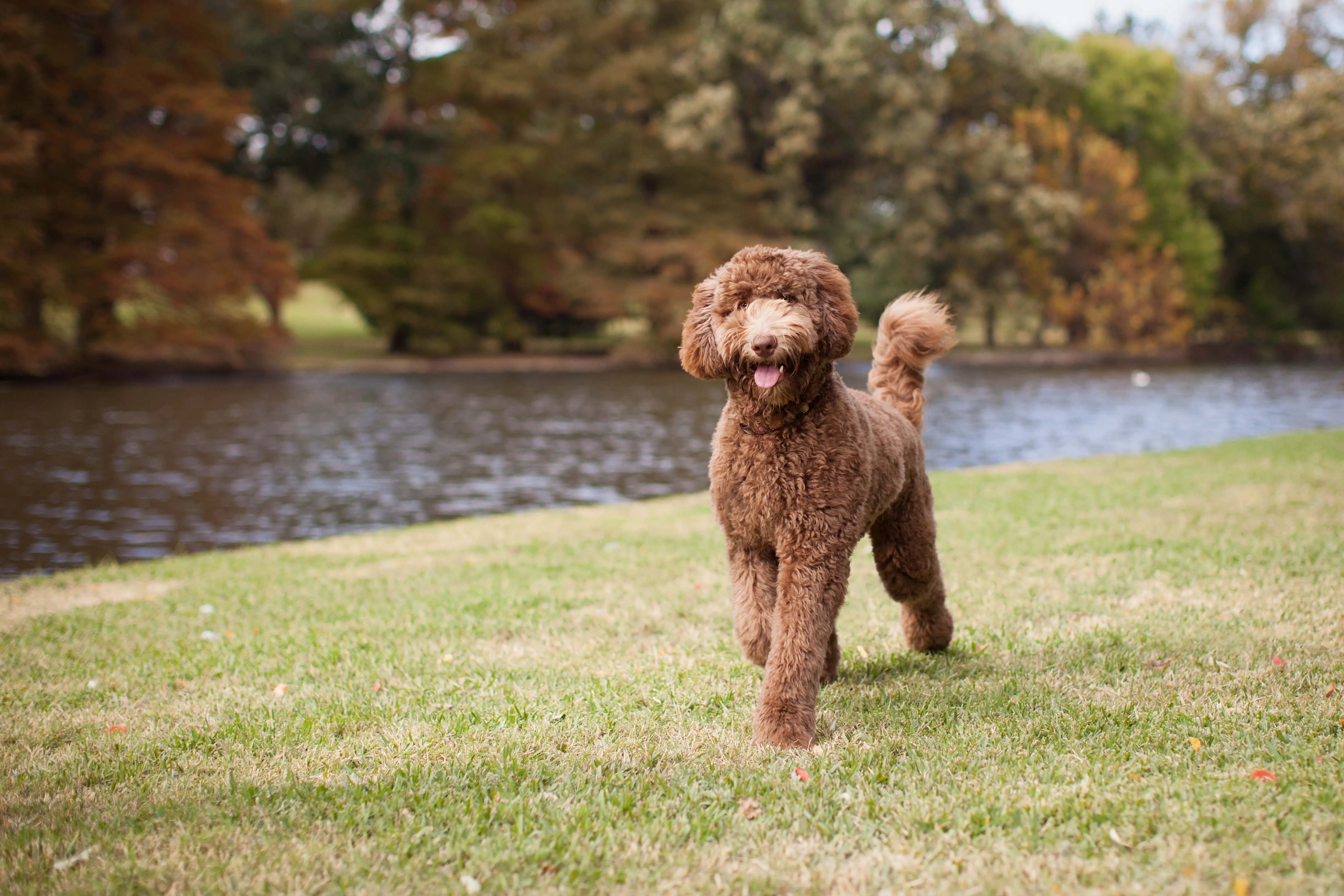 Brown Standard Labradoodle walking through a park on a sunny day
Brown Standard Labradoodle walking through a park on a sunny day
The Labradoodle, a crossbreed between a Labrador Retriever and a Poodle, was originally developed to be a hypoallergenic service dog. Known for their friendly disposition, high intelligence, and trainability, Labradoodles make wonderful family pets. Their coat type can vary (wool, fleece, or hair), with the wool and fleece coats being the most consistent in terms of low shedding. These crossbreed dogs that don’t shed typically shed minimally, making them a popular choice for individuals with allergies. Early socialization and consistent exercise are crucial for a well-adjusted Labradoodle. Regular brushing is necessary to prevent matting, especially for those with wool or fleece coats.
11. Goldendoodle
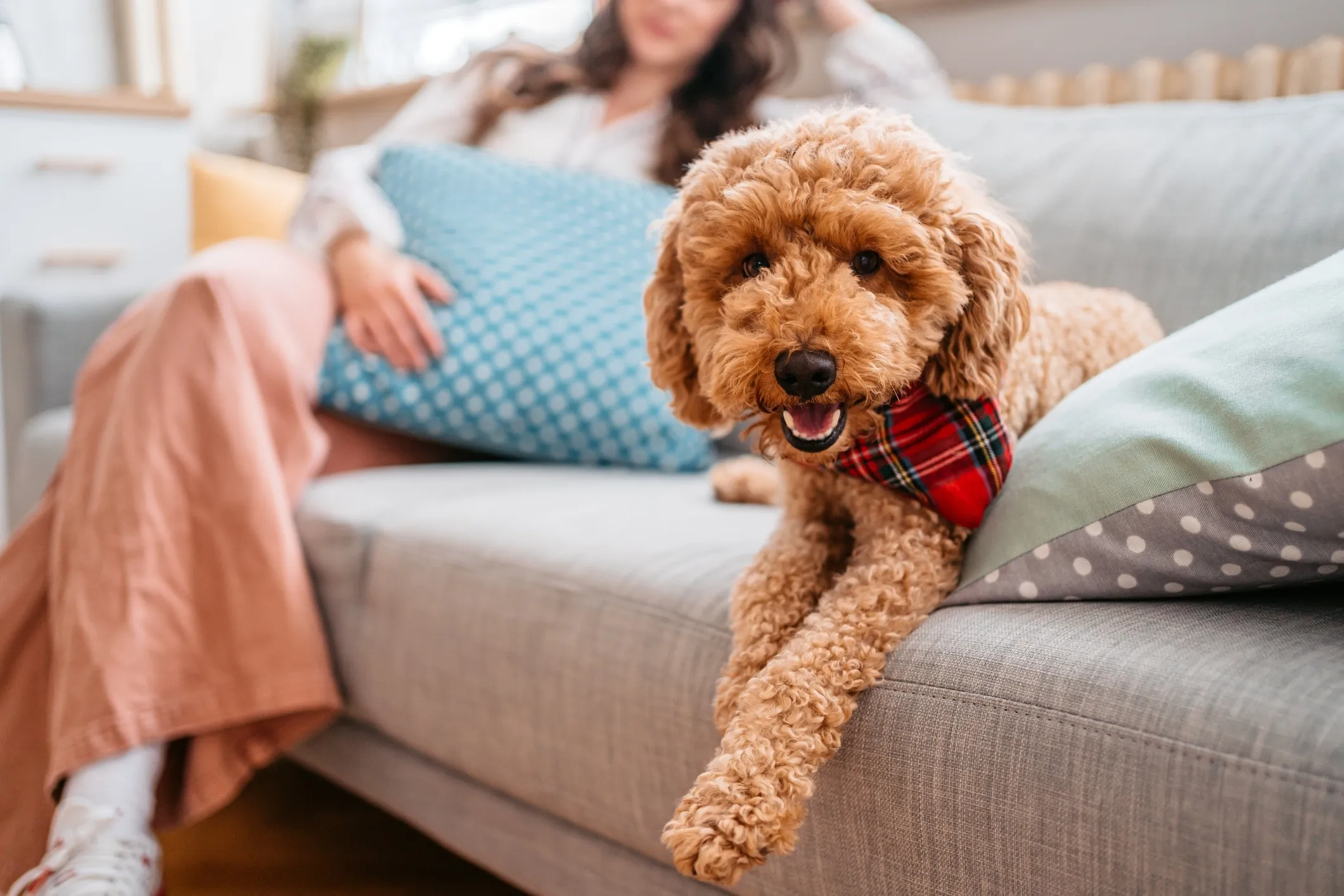 Goldendoodle lying on a couch with a person gently petting its head
Goldendoodle lying on a couch with a person gently petting its head
Another beloved “doodle” breed, Goldendoodles are a cross between a Golden Retriever and a Poodle. Like Labradoodles, they are highly intelligent, friendly, and shed very little, making them ideal for allergy sufferers. Their coats come in various colors and textures, from wavy to curly. Goldendoodles are known for their gentle and patient nature, making them excellent companions for families with children. They require frequent grooming, including regular brushing with a slicker brush, to prevent matting and keep their beautiful coats healthy. Ample exercise is also important to keep these playful pups happy.
12. Lagotto Romagnolo
 Two Lagotto Romagnolo dogs lying in the dirt, looking towards the camera
Two Lagotto Romagnolo dogs lying in the dirt, looking towards the camera
The Lagotto Romagnolo, an ancient Italian water retriever, possesses a dense, curly, woolly coat designed to protect them from cold waters. This unique coat is low-shedding, making them a good option for allergy-prone individuals. Lagotti Romagnoli are intelligent, eager to please, and typically good with children and other pets, making them wonderful family dogs. Their active nature means they enjoy engaging in various dog sports and need consistent mental and physical stimulation. Regular brushing and occasional trimming are necessary to prevent their woolly coat from matting.
13. Affenpinscher
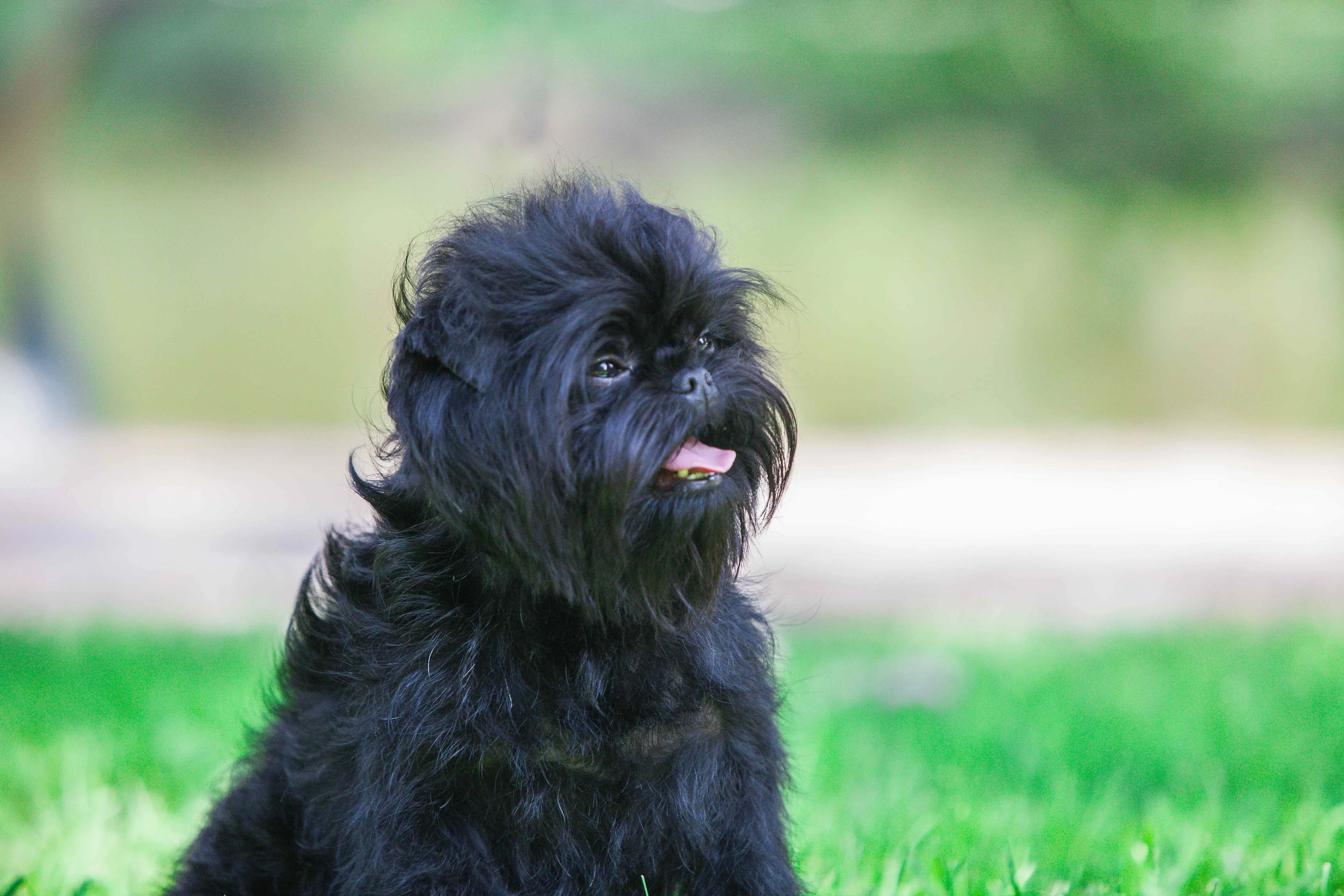 Close-up of a black Affenpinscher dog's face, showing its distinctive wiry hair
Close-up of a black Affenpinscher dog's face, showing its distinctive wiry hair
Affenpinschers are small, charming dogs known for their distinctive monkey-like appearance and spirited personalities. Their dense, wiry coat sheds minimally, classifying them as one of the effective dog breeds that don’t shed too much. While low-shedding, their coat does require regular care, including brushing several times a week and periodic hand-stripping or professional grooming to maintain its texture and appearance. Affenpinschers are affectionate and entertaining companions, though they can be quite tenacious and require consistent training and socialization.
14. Irish Water Spaniel
 Profile shot of a brown Irish Water Spaniel with its characteristic curly coat
Profile shot of a brown Irish Water Spaniel with its characteristic curly coat
The Irish Water Spaniel is a unique and handsome water dog, recognized by its distinctive liver-colored curly coat and “rat tail.” This thick, curly coat is virtually non-shedding, making them a great choice for those seeking a low-shedding dog. Friendly, intelligent, and highly trainable, Irish Water Spaniels have high energy levels and thrive on active lifestyles. They love to swim and retrieve and require substantial daily exercise to keep them happy and healthy. Their coat needs regular brushing and occasional trimming to prevent matting.
15. Aussiedoodle
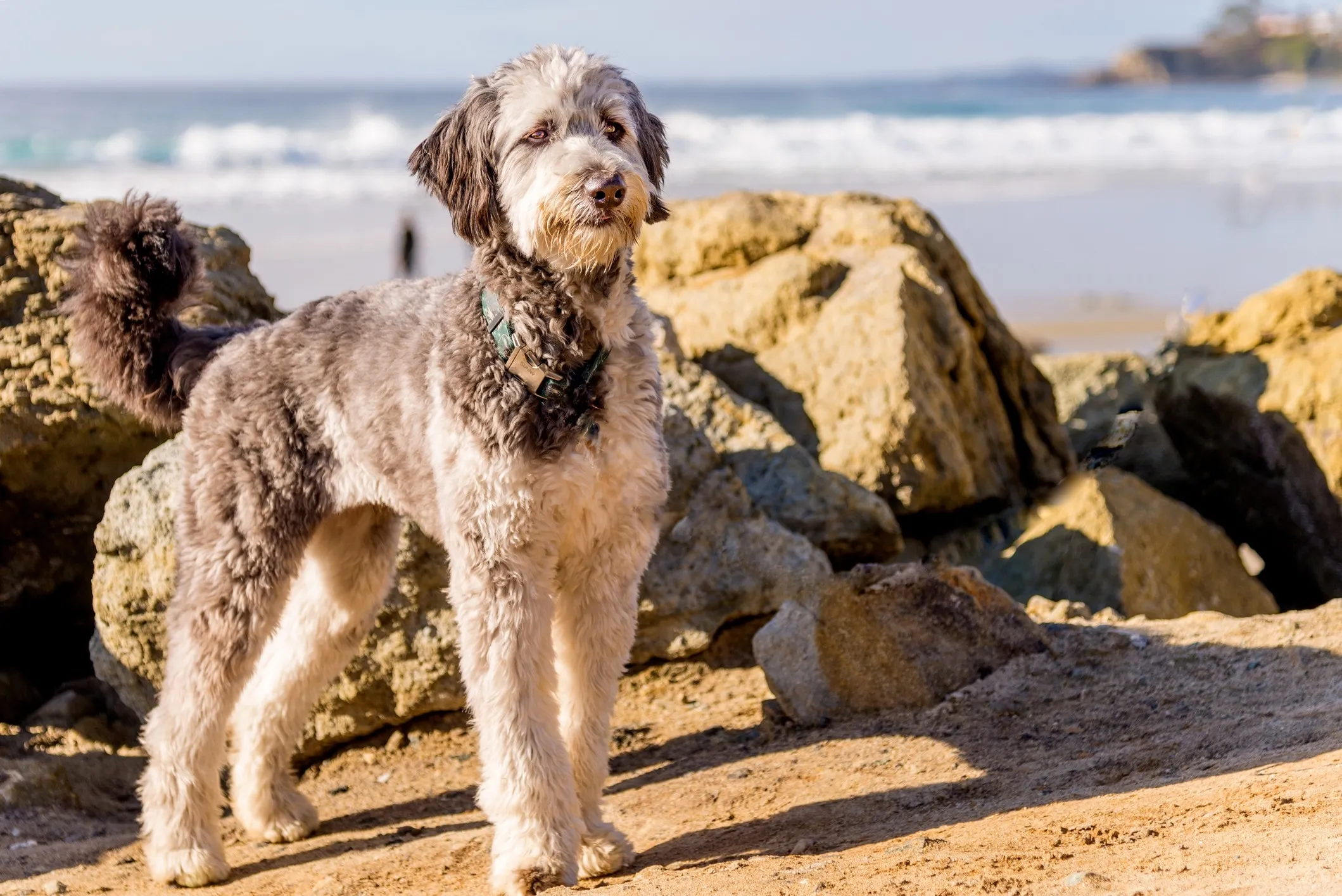 Standard Aussiedoodle dog standing on a sandy beach at sunset
Standard Aussiedoodle dog standing on a sandy beach at sunset
The Aussiedoodle is a cross between an Australian Shepherd and a Poodle, inheriting intelligence and energy from both parent breeds. Their coat can vary from wavy to curly, but generally, they are minimal to low-shedding, especially those with more Poodle-like coats. Aussiedoodles are highly intelligent and energetic dogs that require significant mental stimulation and physical activity to prevent boredom and destructive behaviors. They make excellent companions for active individuals or families who can dedicate time to their exercise and training needs. Regular grooming, including brushing, is important to prevent matting.
16. Bolognese
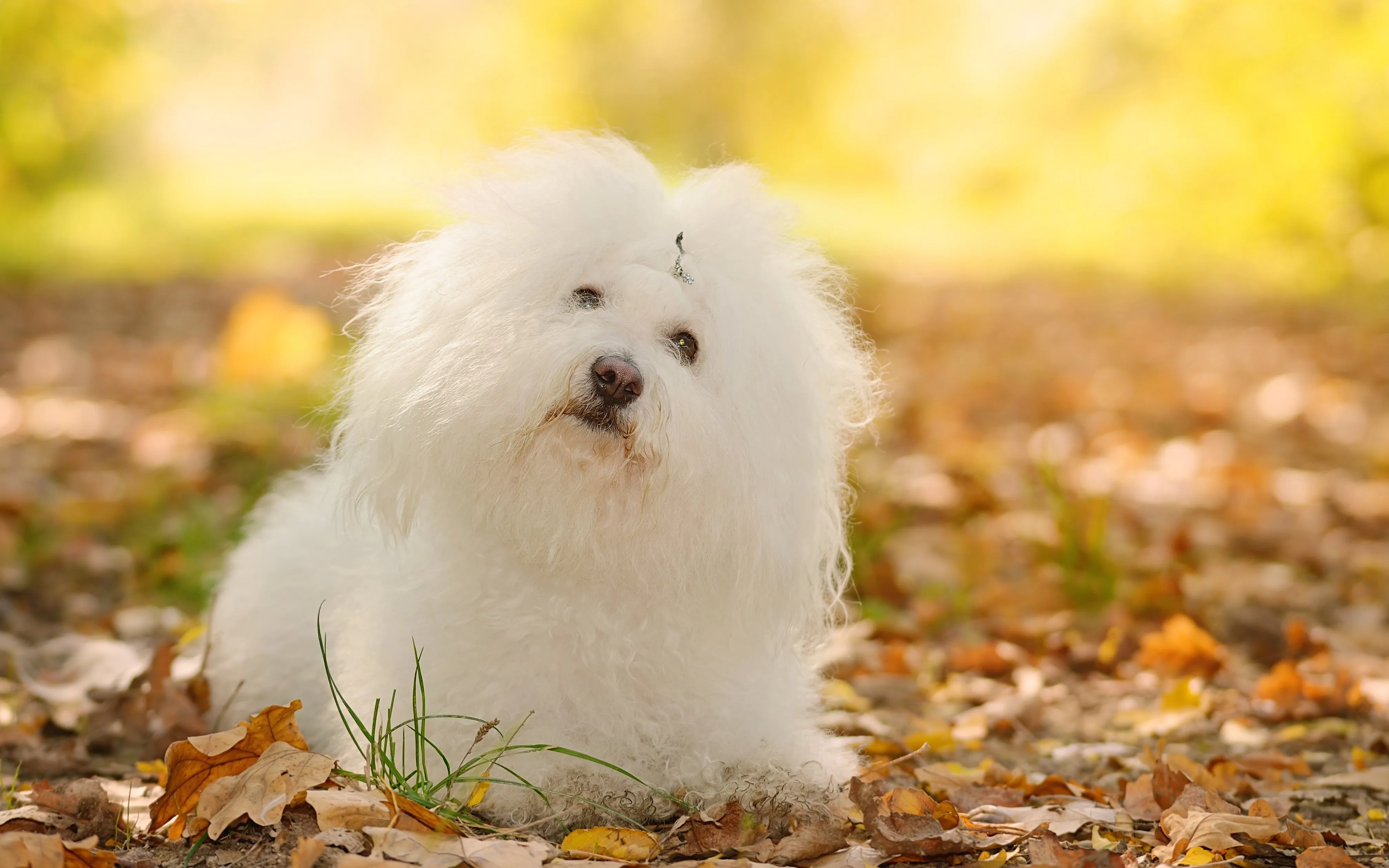 White Bolognese dog sitting amidst autumn leaves in a forest
White Bolognese dog sitting amidst autumn leaves in a forest
Hailing from Italy, the Bolognese is a cute and charming small dog with a long, fluffy white coat that sheds very little. Despite its often “messy” appearance, their single coat requires consistent grooming to prevent tangles and mats. Bolognese dogs are known for their playful, easygoing nature and ability to get along well with children and other pets, making them adaptable to various living situations. They thrive on companionship and are content with moderate exercise, making them ideal lap dogs that are also quite trainable.
17. Maltese
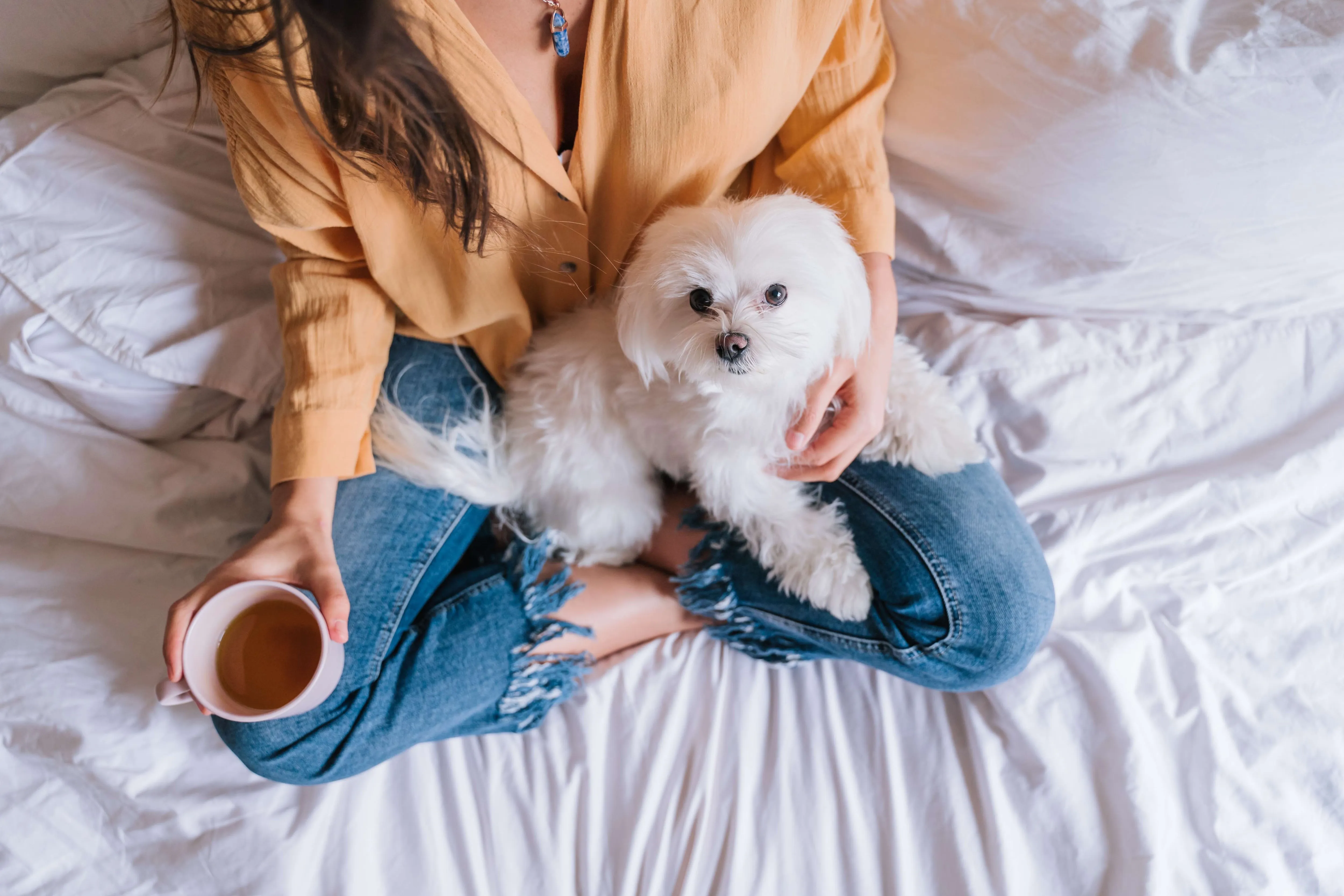 Woman gently holding a small white Maltese dog on a bed
Woman gently holding a small white Maltese dog on a bed
The Maltese is a small, aristocratic dog breed celebrated for its luxurious, flowing white coat. This single-layer coat sheds minimally, making them a favored choice among small dog breeds that don’t shed too much. Maltese are affectionate, playful, and thrive on being close to their human companions. While their long coats are stunning, they demand daily brushing and regular professional grooming to prevent matting. Many owners opt for a shorter “puppy cut” to simplify grooming, especially for active dogs. Despite their delicate appearance, Maltese are surprisingly sturdy and lively.
18. Soft Coated Wheaten Terrier
 Soft Coated Wheaten Terrier dog posing gracefully on a log
Soft Coated Wheaten Terrier dog posing gracefully on a log
The Soft Coated Wheaten Terrier is a medium-sized Irish breed distinguished by its silky, wavy coat that is incredibly soft to the touch and, as its name suggests, sheds minimally. Wheatens are known for their joyful, spirited personalities and boundless energy. They require ample exercise and mental stimulation to keep them happy and well-behaved. Their unique coat demands consistent grooming, including daily brushing to prevent matting, especially after play or outdoor adventures. Wheatens are loving and devoted family dogs, often greeting their owners with an enthusiastic “Wheaten Greetin’.”
19. Coton de Tulear
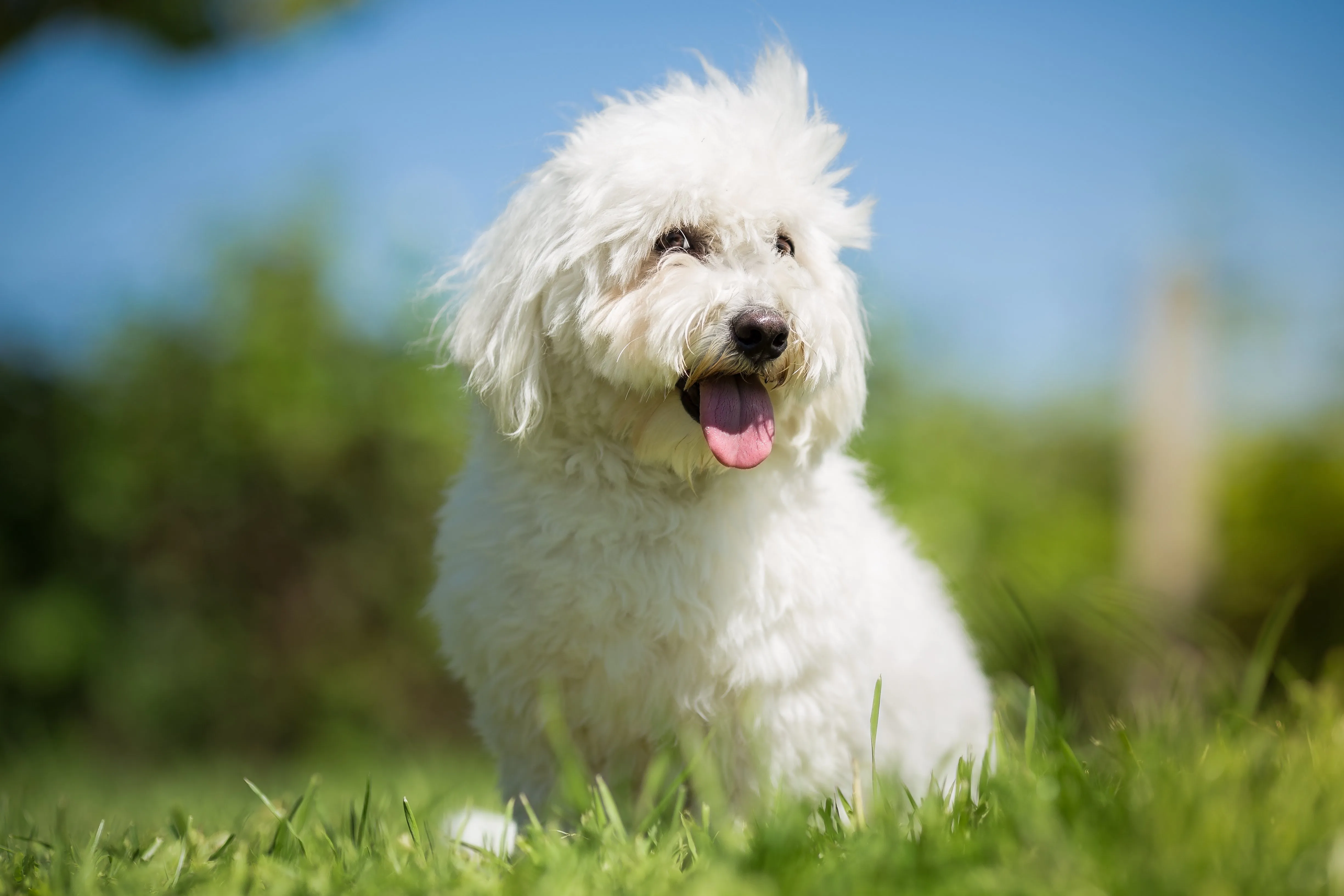 White Coton de Tulear dog sitting in green grass with its hair gently blowing
White Coton de Tulear dog sitting in green grass with its hair gently blowing
Originating from Madagascar, the Coton de Tulear is a small, charming dog with a distinctive cotton-like coat that sheds very little. Their good-natured temperament makes them excellent companions for families, getting along well with children and other pets when properly introduced. Cotons are intelligent, playful, and eager to please, adapting easily to various living environments. Their unique coat requires daily brushing to prevent mats and regular grooming appointments to keep it healthy and manageable.
20. Schnoodle
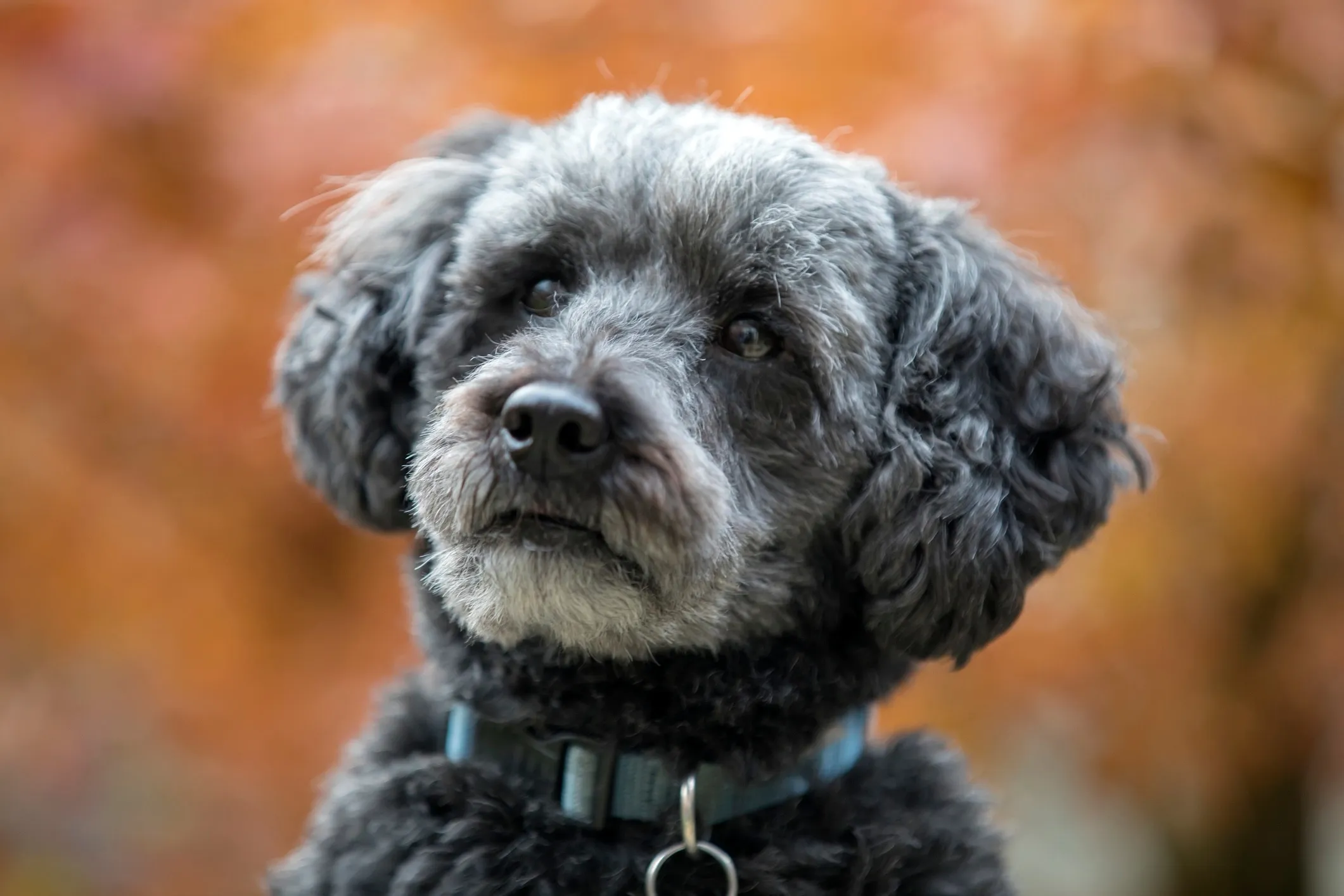 Close-up of a gray Schnoodle dog with expressive eyes
Close-up of a gray Schnoodle dog with expressive eyes
The Schnoodle is a designer breed resulting from crossing two low-shedding breeds: the Schnauzer and the Poodle. This combination often results in a dog with a low-shedding coat that can range from wavy to curly, depending on the genetics inherited from its parents. Schnoodles are known for their intelligence, playful nature, and affectionate personalities. They make wonderful family pets and can thrive in various settings. Like their parent breeds, Schnoodles require regular grooming, including brushing and periodic trimming, to maintain their coat and prevent matting. For those interested in diverse crossbreed dogs that don’t shed, the Schnoodle is a prime example of breeding for specific coat traits.
21. Bedlington Terrier
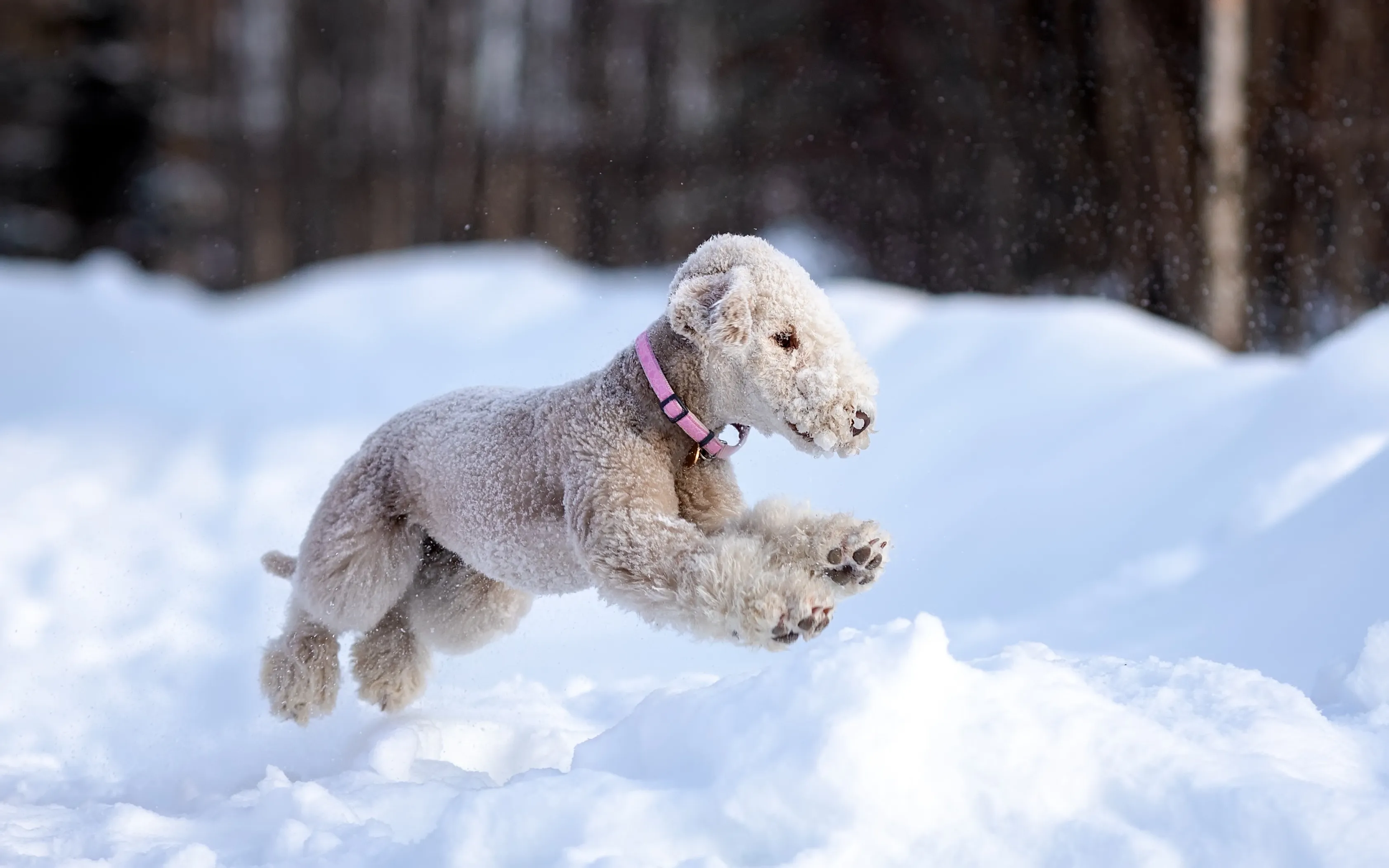 White Bedlington Terrier running playfully through snow
White Bedlington Terrier running playfully through snow
Often described as “a lamb in dog’s clothing,” the Bedlington Terrier is a distinctive small to medium-sized breed with a unique curly, woolly coat that sheds very little. Their soft, lint-like coat requires regular professional grooming and brushing to prevent matting and maintain its signature look. Bedlington Terriers are affectionate, loyal, and energetic dogs who thrive on human companionship. They can be prone to separation anxiety if left alone for extended periods, making them best suited for families who can provide consistent presence and attention. Their playful nature makes them great companions for active individuals.
22. Xoloitzcuintli
 Black Mexican Hairless Dog (Xoloitzcuintli) standing elegantly in green grass
Black Mexican Hairless Dog (Xoloitzcuintli) standing elegantly in green grass
The Xoloitzcuintli, also known as the Mexican Hairless Dog, is one of the oldest and rarest dog breeds. As the name suggests, the hairless variety sheds virtually no hair, making them an excellent choice for allergy sufferers. Xolos also come in a coated variety with a short, smooth coat that sheds minimally. Available in toy, miniature, and standard sizes, these ancient dogs are intelligent, calm, and protective companions. The hairless variety requires special skin care, including sun protection and moisturizing, while the coated variety needs minimal grooming.
23. Whoodle
 Tan Whoodle puppy playfully pulling a washcloth
Tan Whoodle puppy playfully pulling a washcloth
A delightful cross between a Soft Coated Wheaten Terrier and a Poodle, the Whoodle combines the best traits of both low-shedding parents. Whoodles are known for their friendly, affectionate nature and high intelligence, making them highly trainable and wonderful family pets. Their soft, wavy to curly coat sheds very little, making them a popular choice among those seeking dog breeds that don’t shed too much. Like other Poodle mixes, they require regular grooming, including brushing to prevent matting, to keep their coats healthy and beautiful.
24. Bernedoodle
 Large Bernedoodle dog lying in grass with its tongue playfully out
Large Bernedoodle dog lying in grass with its tongue playfully out
The Bernedoodle is a charming crossbreed between a Bernese Mountain Dog and a Poodle, offering a large, affectionate, and low-shedding companion. Known for their gentle demeanor, friendly nature, and intelligence, Bernedoodles make excellent family pets, particularly for those with children and other animals. Their coat type can vary, but generally, they shed minimally, especially those with curly or wavy coats. These big fluffy dog breeds that don’t shed require plenty of exercise to stay happy and healthy, and their coats need regular brushing and professional grooming to prevent mats.
25. Shorkie
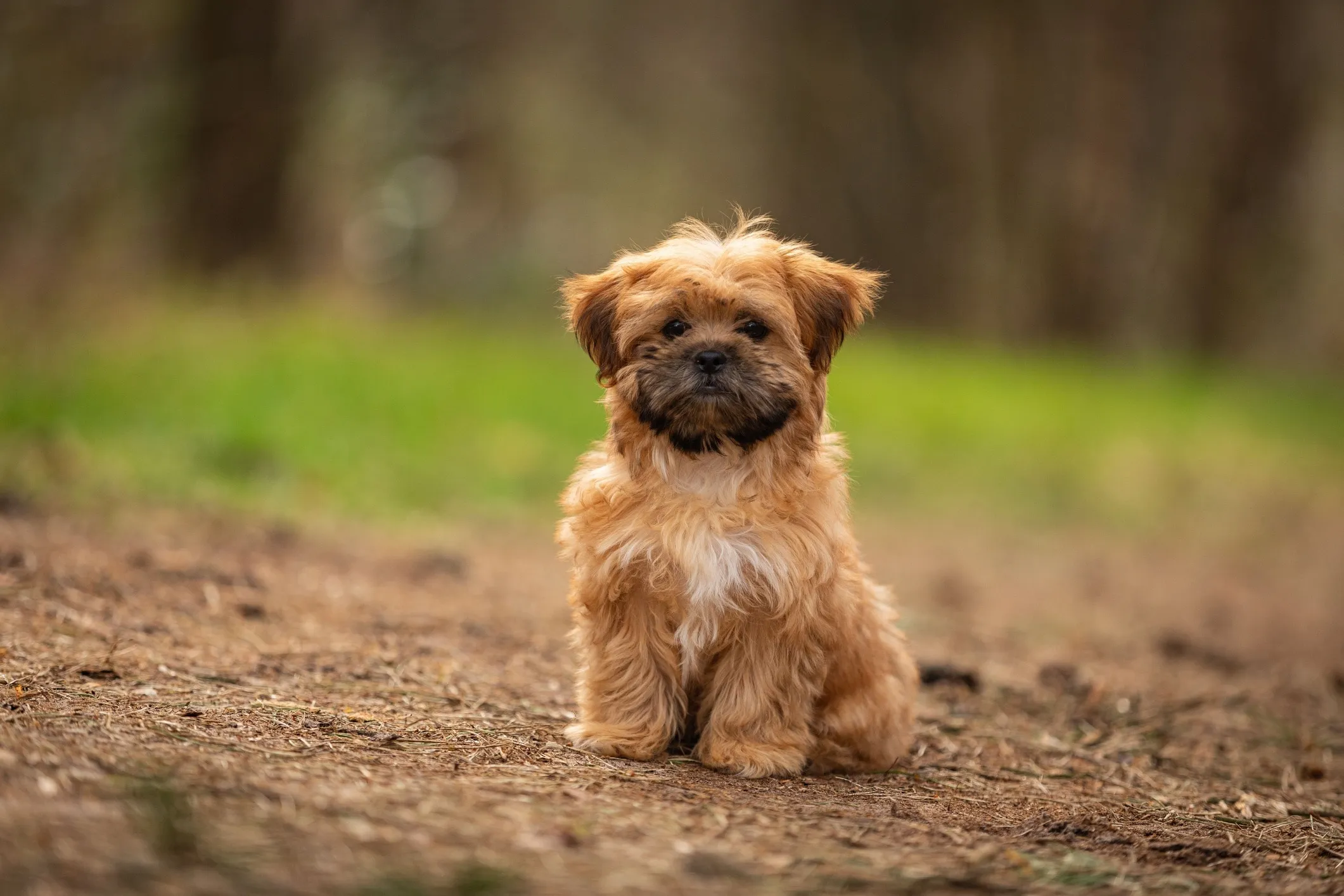 Tan and black Shih Tzu and Yorkie mix (Shorkie) sitting on a hiking trail
Tan and black Shih Tzu and Yorkie mix (Shorkie) sitting on a hiking trail
The Shorkie is a mixed breed resulting from a cross between two low-shedding breeds: the Shih Tzu and the Yorkshire Terrier. This combination results in a small, playful, and friendly dog that inherits the best characteristics of both parents. Shorkies are known for their affectionate nature and adaptability to various living situations. Their coats, while low-shedding, require a dedicated regular grooming routine, including daily brushing, to keep them free of tangles and mats.
26. Afghan Hound
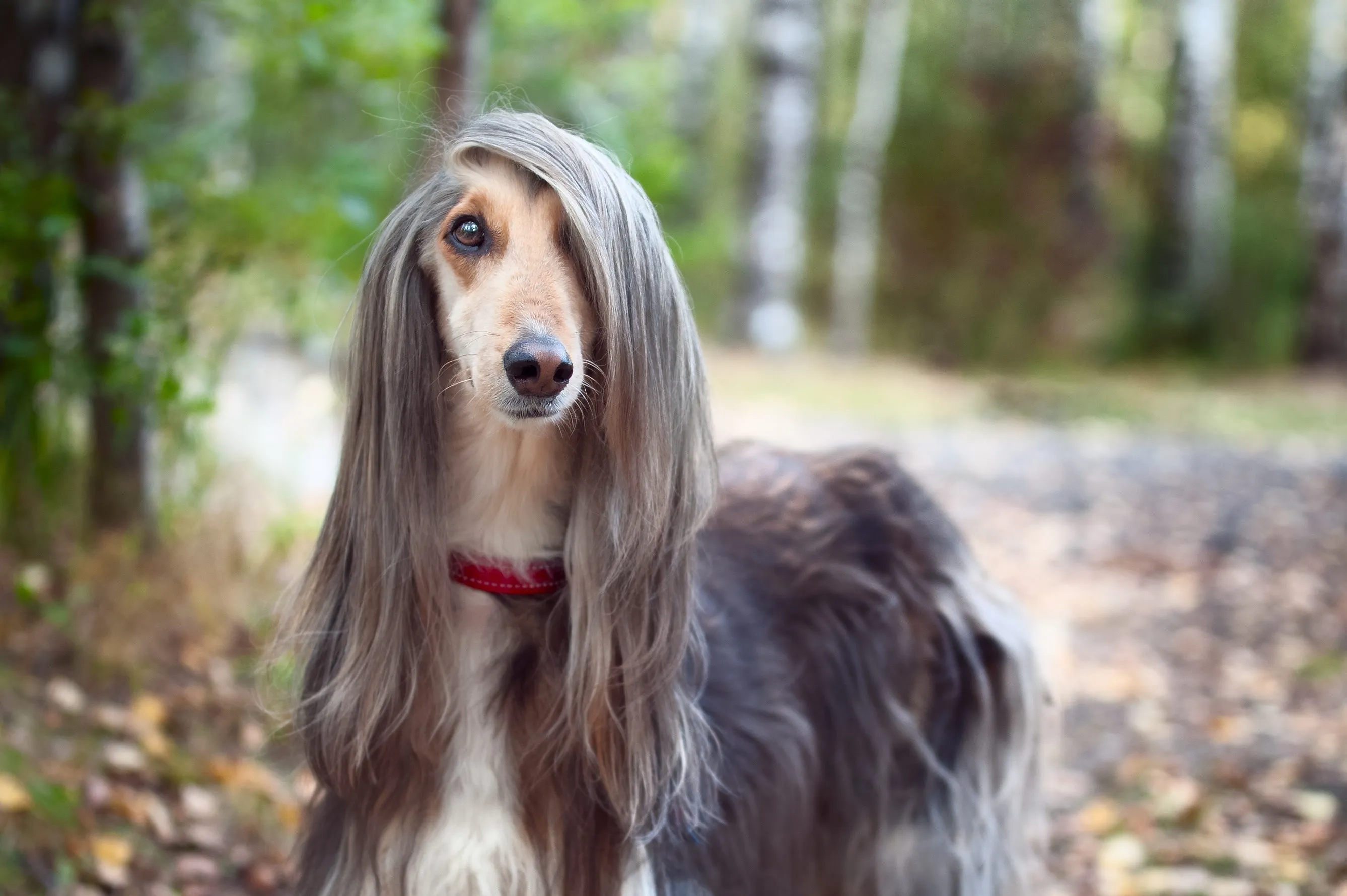 Gray and tan Afghan Hound looking regal and alert at the camera
Gray and tan Afghan Hound looking regal and alert at the camera
The Afghan Hound stands out with its incredibly long, flowing coat and slender, aristocratic build. Despite their abundant hair, Afghan Hounds are considered low-shedding compared to many other breeds. Their unique coat demands a significant grooming commitment, including frequent brushing and bathing, to prevent matting and maintain its luxurious appearance. These dogs are built for speed and endurance, requiring considerable exercise. Afghan Hounds are loyal and loving towards their families but can be reserved with strangers, emphasizing the importance of early and consistent socialization.
27. Barbet
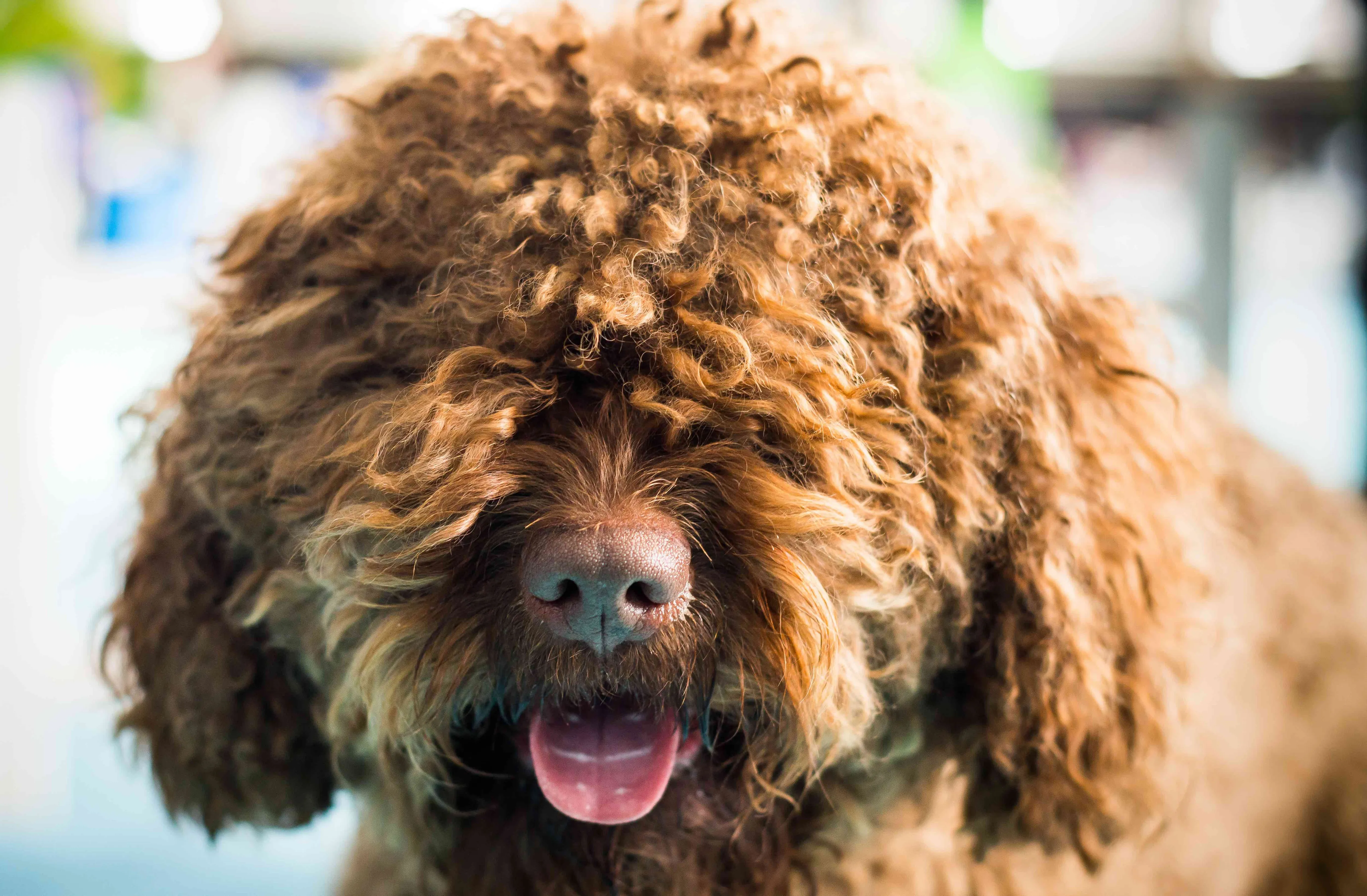 Close-up of a curly red Barbet dog's face with its characteristic beard
Close-up of a curly red Barbet dog's face with its characteristic beard
The Barbet, pronounced “bar-bay” and named after the French word for “beard,” is a cheerful and shaggy pup with a dense, woolly, curly coat that sheds minimally. This protective coat makes them excellent swimmers and helps them thrive in water activities, reflecting their original purpose as water retrievers. Barbets are intelligent, friendly, and eager to please, making them good family companions. Their distinctive coat requires regular grooming, including brushing two to three times a week with a slicker or pin brush, especially after swimming, to keep it free of mats and in good condition.
28. Shih-Poo
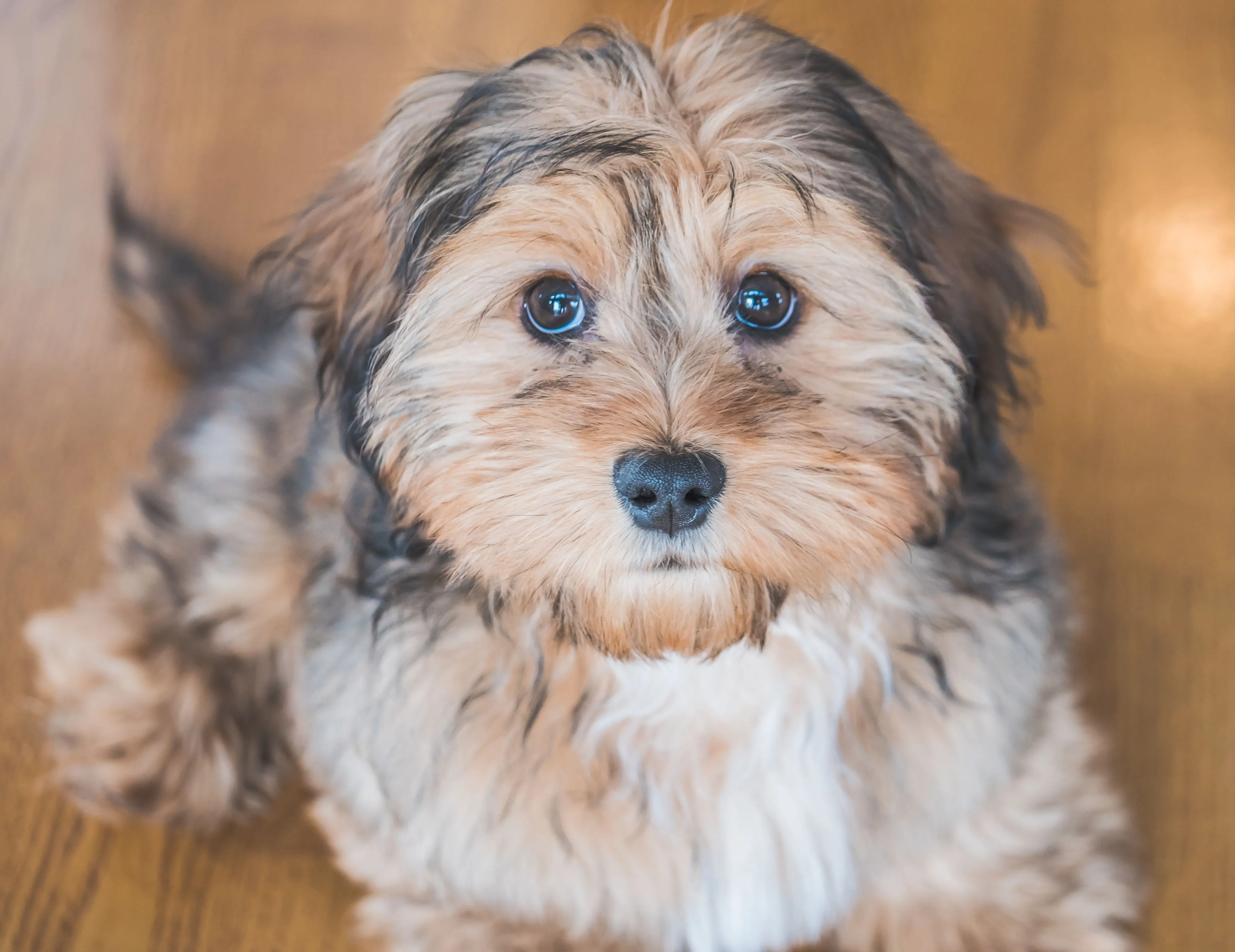 Tan and black Shih-Poo dog close-up with a friendly expression
Tan and black Shih-Poo dog close-up with a friendly expression
The Shih-Poo is a charming mixed breed, typically a cross between a Shih Tzu and a Toy Poodle. This small dog often inherits the best qualities of both parents: a friendly, outgoing personality and a low-shedding coat. Shih-Poos are adaptable and can thrive in almost any living situation, from apartments to larger homes, as long as they receive adequate attention and daily exercise. Their coat requires regular brushing, ideally daily, to prevent tangles and mats, ensuring they stay comfortable and well-groomed.
29. Peruvian Inca Orchid
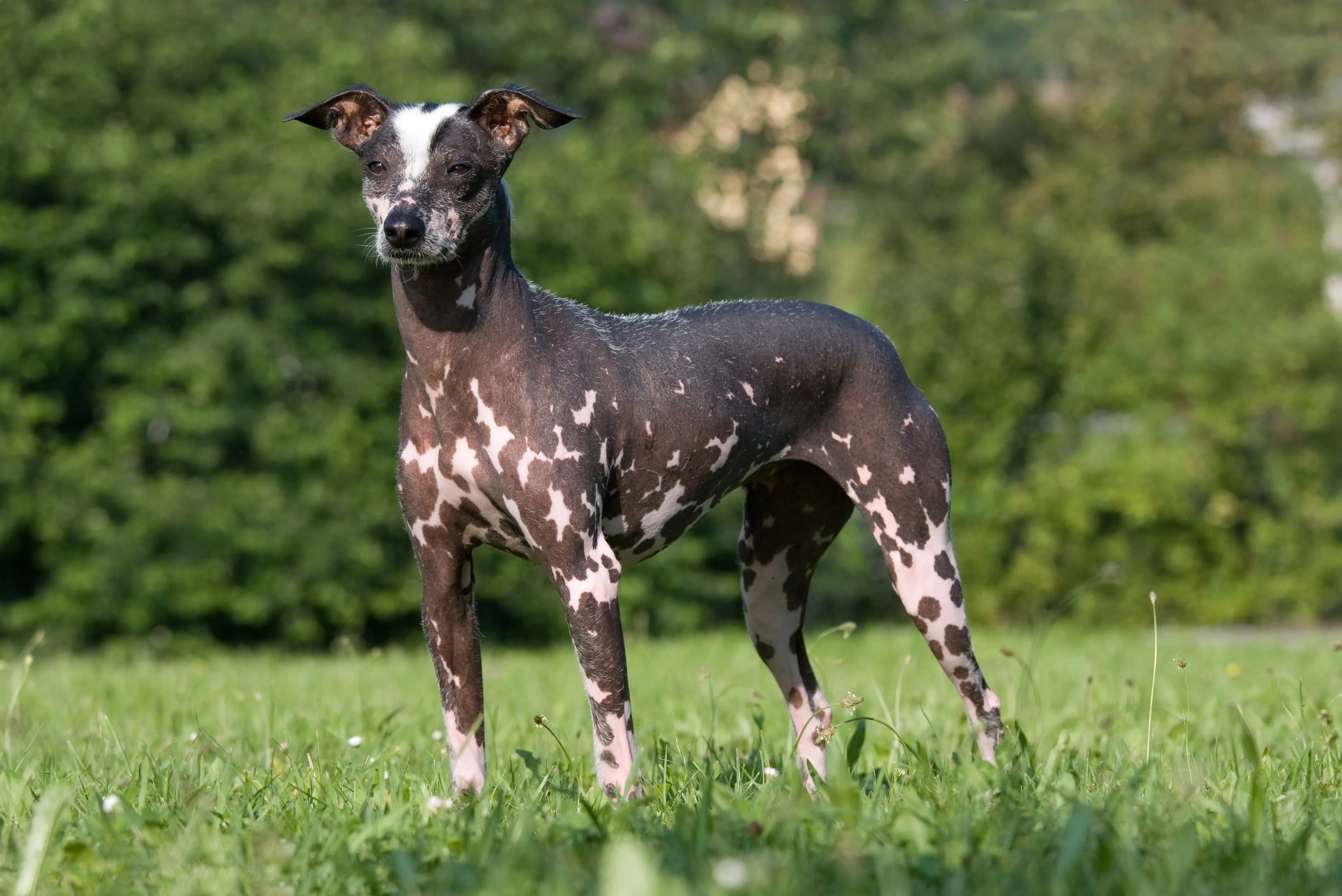 Peruvian Inca Orchid dog with its unique hairless body
Peruvian Inca Orchid dog with its unique hairless body
The Peruvian Inca Orchid is an ancient and rare breed known for its distinctive appearance, primarily being hairless. This characteristic makes them a natural choice for those seeking dog breeds that don’t shed too much, as the hairless variety sheds virtually nothing. They come in three sizes (small, medium, and large) and are the national dog of Peru. Peruvian Inca Orchids are elegant, alert, and affectionate companions. While the hairless variety requires specific skin care (sun protection and moisturizing), they are otherwise relatively low-maintenance in terms of grooming.
30. Malshi
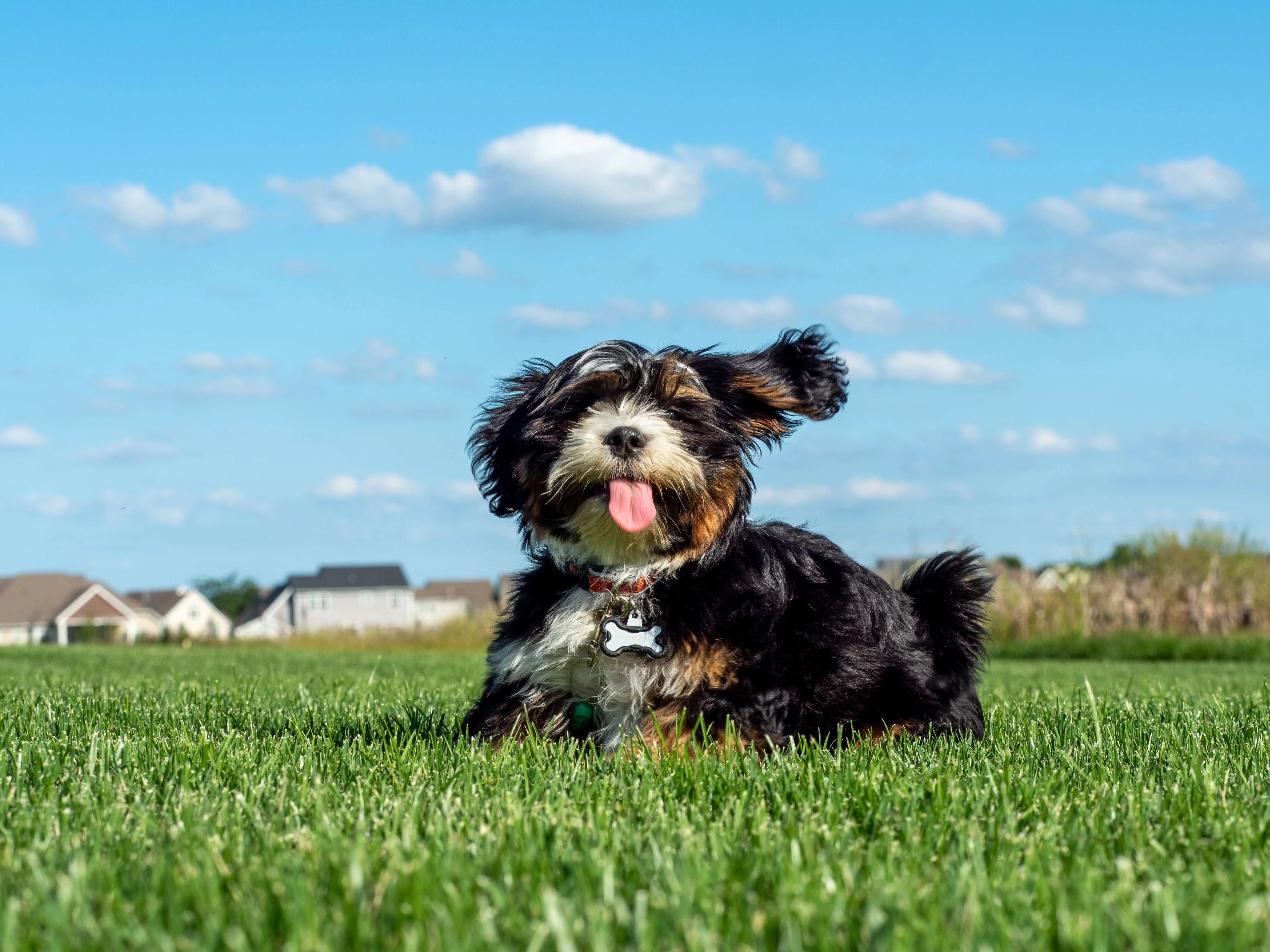 Tricolor Malshi dog sitting gracefully in green grass
Tricolor Malshi dog sitting gracefully in green grass
The Malshi is a delightful cross between the Maltese and Shih Tzu, resulting in a small, happy, and affectionate dog. Inheriting low-shedding traits from both parent breeds, the Malshi is an excellent choice for allergy sufferers. These charming dogs thrive on close companionship and love being near their favorite humans. Malshis are playful and adapt well to various home environments, making them ideal lap dogs. Their soft, flowing coats, while low-shedding, do require consistent grooming, including daily brushing, to prevent matting and maintain their beautiful appearance. For families looking for a delightful and low-maintenance furry friend, Malshis offer a wonderful blend of traits. If you’re looking for good family dogs that don’t shed, the Malshi could be a perfect fit.
Essential Tips for Living with a Low-Shedding Dog
While these dog breeds that don’t shed too much can significantly reduce allergens and loose hair in your home, it’s vital to implement a few key practices to maintain a clean and allergy-friendly environment.
Keep Up With Grooming
Even low-shedding dogs require consistent grooming to prevent their coats from matting and to minimize any dander that might still be present.
- Brushing: Brush your dog several times a week, or even daily for some breeds, using the appropriate brush type for their coat (e.g., slicker brush for curly coats, pin brush for long, silky coats). This helps remove loose hair and dead skin cells before they can be shed into your home.
- Bathing: Bathe your dog every 4-6 weeks with a gentle, moisturizing dog shampoo. Some owners find specialized dander-reducing shampoos beneficial. Regular bathing helps to wash away allergens from their skin and coat.
- Professional Grooming: Many low-shedding breeds require regular professional grooming, including clipping or hand-stripping, every 6-8 weeks. Factor this into your budget or learn how to maintain their coat at home.
Maintain a Clean House
A clean home environment is crucial for managing allergens, even with a low-shedding dog.
- Vacuum Regularly: Use a vacuum cleaner with a HEPA filter to thoroughly clean carpets, rugs, and upholstery several times a week.
- Dust Frequently: Dust surfaces with a damp cloth to capture airborne dander.
- Wash Bedding: Wash your dog’s bedding and your own bedding regularly in hot water to eliminate allergens.
- Air Filtration: Consider using air purifiers with HEPA filters in main living areas to capture airborne allergens.
- Keep Pet-Free Zones: Designate certain areas of your home, such as bedrooms, as pet-free zones to create allergen sanctuaries.
Talk to Your Doctor
If you or a family member has dog allergies, consulting with a healthcare provider or allergist is an essential step. They can help you:
- Confirm Allergies: Identify specific allergens that trigger reactions.
- Develop a Management Plan: Discuss various treatment options, including antihistamines, nasal sprays, or allergy shots (immunotherapy), to effectively manage symptoms.
- Provide Personalized Advice: Offer tailored recommendations for living with a dog while minimizing allergic reactions.
Conclusion
Choosing a dog is a significant decision, especially when allergies or a desire for a cleaner home are factors. Opting for dog breeds that don’t shed too much can open up the wonderful world of dog ownership for many who previously thought it wasn’t possible. While no dog is entirely allergen-free, these low-shedding breeds offer a viable path to enjoying the immense love and companionship that dogs provide with fewer concerns about dander and loose fur.
Remember, every dog is an individual, and even within low-shedding breeds, there can be variations. Spend time with a breed before bringing them home to ensure they are the right fit for your family and lifestyle. With proper grooming, a clean home, and consultation with your doctor, you can enjoy a happy and healthy life with your chosen low-shedding canine companion. Explore our website for more expert insights into pet care and discover the perfect furry friend for your home!
